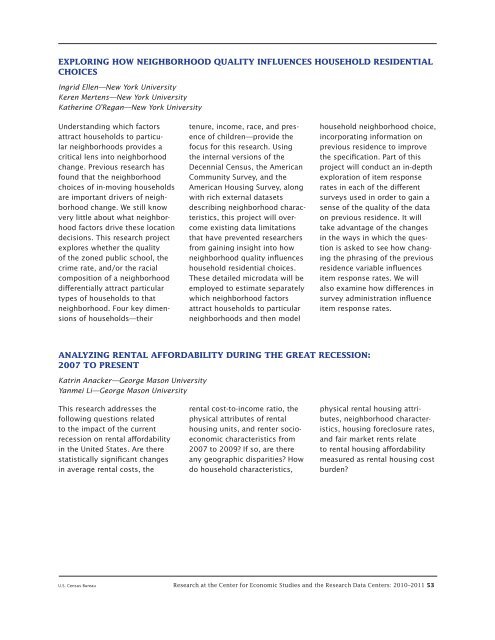2010 and 2011 - Census Bureau
2010 and 2011 - Census Bureau
2010 and 2011 - Census Bureau
You also want an ePaper? Increase the reach of your titles
YUMPU automatically turns print PDFs into web optimized ePapers that Google loves.
exploring How neigHborHood QuAlity inFluences HouseHold residentiAl<br />
cHoices<br />
Ingrid Ellen—New York University<br />
Keren Mertens—New York University<br />
Katherine O’Regan—New York University<br />
Underst<strong>and</strong>ing which factors<br />
attract households to particular<br />
neighborhoods provides a<br />
critical lens into neighborhood<br />
change. Previous research has<br />
found that the neighborhood<br />
choices of in-moving households<br />
are important drivers of neighborhood<br />
change. We still know<br />
very little about what neighborhood<br />
factors drive these location<br />
decisions. This research project<br />
explores whether the quality<br />
of the zoned public school, the<br />
crime rate, <strong>and</strong>/or the racial<br />
composition of a neighborhood<br />
differentially attract particular<br />
types of households to that<br />
neighborhood. Four key dimensions<br />
of households—their<br />
tenure, income, race, <strong>and</strong> presence<br />
of children—provide the<br />
focus for this research. Using<br />
the internal versions of the<br />
Decennial <strong>Census</strong>, the American<br />
Community Survey, <strong>and</strong> the<br />
American Housing Survey, along<br />
with rich external datasets<br />
describing neighborhood characteristics,<br />
this project will overcome<br />
existing data limitations<br />
that have prevented researchers<br />
from gaining insight into how<br />
neighborhood quality influences<br />
household residential choices.<br />
These detailed microdata will be<br />
employed to estimate separately<br />
which neighborhood factors<br />
attract households to particular<br />
neighborhoods <strong>and</strong> then model<br />
AnAlyzing rentAl AFFordAbility during tHe greAt recession:<br />
2007 to present<br />
Katrin Anacker—George Mason University<br />
Yanmei Li—George Mason University<br />
This research addresses the<br />
following questions related<br />
to the impact of the current<br />
recession on rental affordability<br />
in the United States. Are there<br />
statistically significant changes<br />
in average rental costs, the<br />
rental cost-to-income ratio, the<br />
physical attributes of rental<br />
housing units, <strong>and</strong> renter socioeconomic<br />
characteristics from<br />
2007 to 2009? If so, are there<br />
any geographic disparities? How<br />
do household characteristics,<br />
household neighborhood choice,<br />
incorporating information on<br />
previous residence to improve<br />
the specification. Part of this<br />
project will conduct an in-depth<br />
exploration of item response<br />
rates in each of the different<br />
surveys used in order to gain a<br />
sense of the quality of the data<br />
on previous residence. It will<br />
take advantage of the changes<br />
in the ways in which the question<br />
is asked to see how changing<br />
the phrasing of the previous<br />
residence variable influences<br />
item response rates. We will<br />
also examine how differences in<br />
survey administration influence<br />
item response rates.<br />
physical rental housing attributes,<br />
neighborhood characteristics,<br />
housing foreclosure rates,<br />
<strong>and</strong> fair market rents relate<br />
to rental housing affordability<br />
measured as rental housing cost<br />
burden?<br />
U.S. <strong>Census</strong> <strong>Bureau</strong> Research at the Center for Economic Studies <strong>and</strong> the Research Data Centers: <strong>2010</strong>–<strong>2011</strong> 53

















